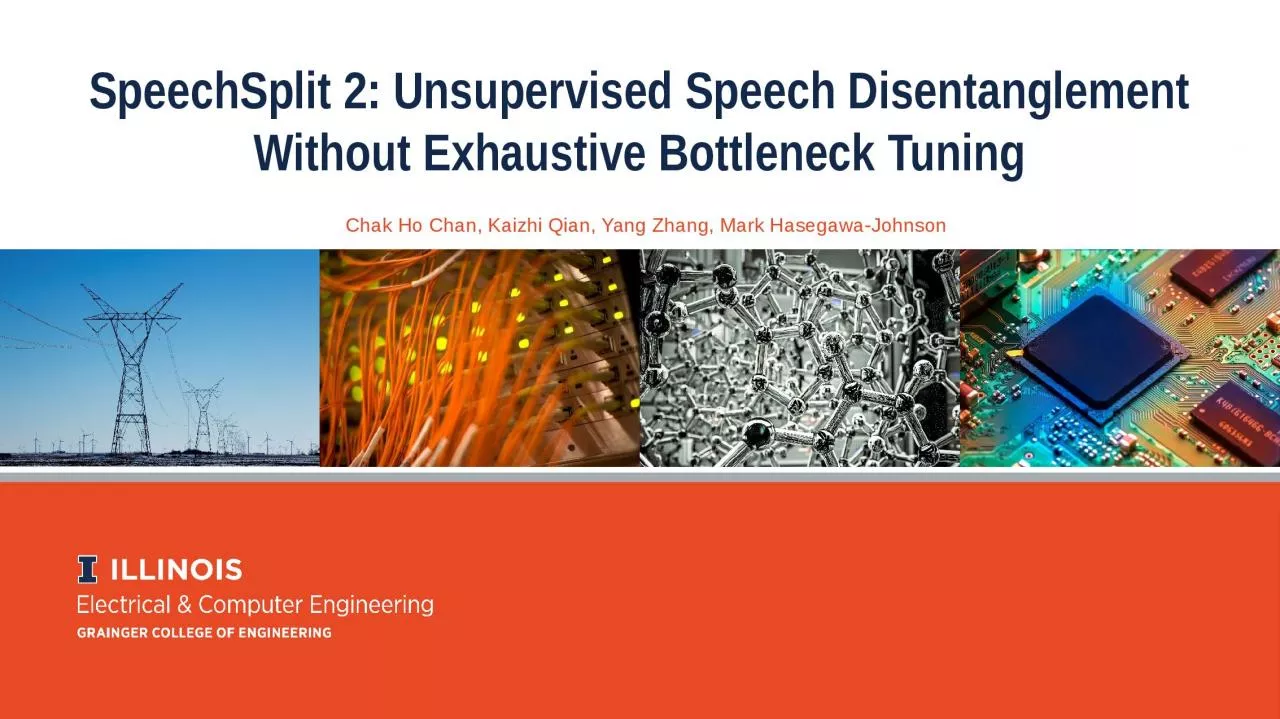

Chak Ho Chan Kaizhi Qian Yang Zhang Mark HasegawaJohnson Speech contains very rich and complex information Challenge It is hard to modify a particular aspect of speechduration pitch timbre etc while keeping the others unchanged ID: 919855
Download Presentation The PPT/PDF document "SpeechSplit 2: Unsupervised Speech Disen..." is the property of its rightful owner. Permission is granted to download and print the materials on this web site for personal, non-commercial use only, and to display it on your personal computer provided you do not modify the materials and that you retain all copyright notices contained in the materials. By downloading content from our website, you accept the terms of this agreement.
Slide1
SpeechSplit 2: Unsupervised Speech Disentanglement Without Exhaustive Bottleneck Tuning
Chak Ho Chan, Kaizhi Qian, Yang Zhang, Mark Hasegawa-Johnson
Slide2Speech contains very rich and complex information
Challenge: It is hard to modify a particular aspect of speech(duration, pitch, timbre, etc.) while keeping the others unchanged
Solution: Speech DisentanglementVAE-based(Hsu et al., 2017)GAN-based(Zhou et al., 2020)Contrastive Learning(Ebbers et al., 2021)
Background
2
Slide3So far, most approaches only focus on converting a single attribute(timbre)
SpeechSplit(Qian et al., 2020) disentangles speech into four components: rhythm, content, pitch, and timbre
Background (Cont.)
3
Slide4Why does it work?
Random resampling corrupts the rhythm information in the content and pitch encoder inputs
Carefully tune the rhythm encoder bottleneck so that it only encodes rhythm but not content/pitch/timbreCarefully tune the content encoder bottleneck so that it only encodes content but not pitch/timbre
Carefully tune the pitch encoder bottleneck and normalize the pitch contour so that it only encodes pitch
Background (Cont.)
4
Slide5Why does it work?
Random resampling corrupts the rhythm information in the content and pitch encoder inputs
Carefully tune the rhythm encoder bottleneck so that it only encodes rhythm but not content/pitch/timbreCarefully tune the content encoder bottleneck so that it only encodes content but not pitch/timbre
Carefully tune the pitch encoder bottleneck and normalize the pitch contour so that it only encodes pitchProblem: Exhaustive bottleneck tuning
Background (Cont.)
5
Slide6SpeechSplit 2: Solve the bottleneck tuning issue in SpeechSplit using signal processing methods
Step 1: Remove the pitch dynamics along time in speech(“pitch smoother”)
Analyze the signal using WORLD analyzer, which extracts spectral envelope, F0 contour, and aperiodicityFor each utterance, replace the F0 contour with its mean valueResynthesize the signal using WORLD synthesizer
Proposed Method
6
Slide7Step 2: Corrupt the timbre information using Vocal Tract Length Perturbation(
Jaitly et al., 2013)
Step 3: With both pitch and timbre components removed, randomly resample the processed spectrogram and feed it into the content encoderStep 4: Extract the corresponding spectral envelope and feed it into the rhythm encoderProposed Method (Cont.)
7
Slide8Train both models using small and large bottleneck settings
Perform subjective evaluations on Amazon Mechanical Turk(MTurk)
For each model, apply rhythm-, pitch- and timbre-only conversions between utterance pairs that are conceptually distinct in these aspectsEach pair and the converted result are presented to 5 subjects on MTurkThe subjects are asked to select which reference is closer to the converted utterance in terms of all three aspects
Measure the conversion rate, defined as the percentage of subjects who select the target utterance
Experiments
8
Slide9Original
PS
VTLPPS+VTLP
Demo
9
https://biggytruck.github.io/
Slide10Leveraging signal processing methods, the proposed method achieves comparable performance in speech disentanglement without laborious bottleneck tuning
No need to fine-tune the bottleneck for different applications and corpus
Future work: apply the work to improving atypical speech recognition, e.g., dysarthricConclusion
10
Slide11K. Zhou, Berrak Sisman, and H. Li, “VAW-GAN for dis-entanglement and recomposition of emotional elementsin speech,”ArXiv, vol. abs/2011.02314, 2020.
K. Zhou, Berrak Sisman, and H. Li, “VAW-GAN for dis-entanglement and recomposition of emotional elementsin speech,”ArXiv, vol. abs/2011.02314, 2020.
Janek Ebbers, Michael Kuhlmann, Tobias Cord-Landwehr, and Reinhold Haeb-Umbach, “Contrastivepredictive coding supported factorized variational au-toencoder for unsupervised learning of disentangledspeech representations,” in IEEEInternational Conference on Acoustics, Speech and Sig-nal Processing (ICASSP), 2021, pp. 3860–3864.Kaizhi Qian, Yang Zhang, Shiyu Chang, MarkHasegawa-Johnson, and David Cox,“Unsupervisedspeech decomposition via triple information bottle-neck,” inProceedings of the 37th International Con-ference on Machine Learning, 2020, pp. 7836–7846.
References
11
Slide12Navdeep Jaitly and Geoffrey E. Hinton, “Vocal TractLength Perturbation (VTLP) improves speech recogni-tion,” inIn International Conference on Machine Learn-ing (ICML), 2013.
References
12